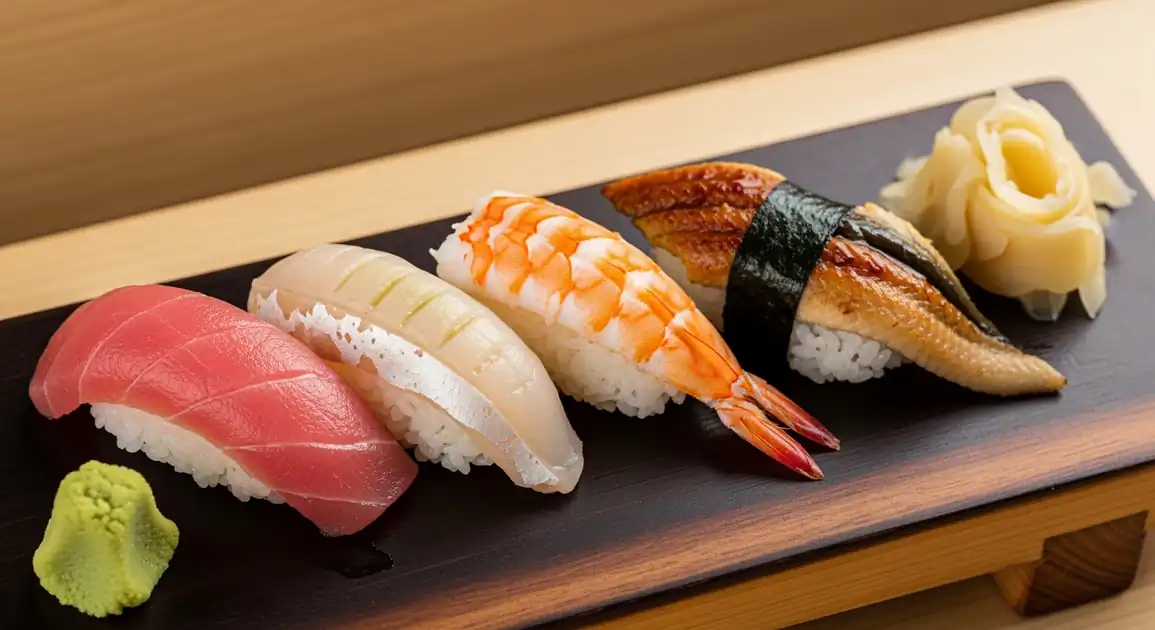Edomae Sushi
江戸前寿司 (Edomae-zushi)

Description
Edomae sushi is found throughout Japan, but its highest concentration and arguably purest form remain in its birthplace, Tokyo. Standards for sushi are exceptionally high nationwide, with chefs training for years. Regional variations exist, but the Edomae principles influence much of Japan's quality sushi.
Dietary Information
Serving information
Serving style
Most commonly served at a counter directly by the chef ('itamae'), often piece by piece for omakase. Table service with sets ('moriawase') or à la carte is also common. Soy sauce and pickled ginger ('gari') are provided.
Quick facts
Lunch: ~11:30 AM - 2:00 PM. Dinner: ~5:30 PM - 10:00 PM. Many independent sushi-ya close one day a week (often Sunday or Monday) and on public holidays.
Safety Tips
What to Look For
-
Reputable, specialized sushi restaurant ('sushi-ya')
Expertise in sourcing, handling, and preparing raw fish is paramount. Look for established places with good reviews or recommendations.
-
Visible freshness of ingredients ('neta')
Fish should look glossy, vibrant, and firm, not dull, dry, or discolored. Check the appearance of items in the display case (if applicable).
-
Impeccable cleanliness of the counter, utensils, and chef's hands
High hygiene standards are essential for raw food preparation. Observe the chef's practices.
-
Chef ('itamae') works skillfully and confidently
Proper technique minimizes handling time and ensures correct preparation, contributing to safety and quality.
-
Sushi rice ('shari') served at body temperature
This is the traditional way and indicates fresh preparation, contrasting with cold, pre-made sushi.
-
Good turnover of customers
Especially in mid-range or market settings, busy places suggest ingredients are fresh and move quickly.
What to avoid
-
Establishments with poor hygiene or low ratings/reviews
Avoid places that look unclean or have documented issues. Trust local review sites (e.g., Tabelog).
-
Fish that looks dull, dry, mushy, or discolored
These are clear signs that the fish is not fresh or has been handled poorly.
-
Strong 'fishy' or unpleasant odors
Fresh, high-quality seafood should smell clean like the ocean, not overtly fishy.
-
Pre-made sushi sitting out for extended periods
Unless from a very reputable source known for high turnover take-away, freshly made is always safer and better.
-
Suspiciously cheap prices for premium items (e.g., Otoro, Uni)
Extremely low prices can sometimes indicate compromised quality or sourcing.
Price information
Price range
Budget tips
- Lunch sets ('ランチセット') offer great value, often under 3000 JPY.
- Kaitenzushi (conveyor belt) provides affordable options (plates from 100-500 JPY).
- Sushi stalls in fish markets can offer fresh, reasonably priced sets.
- Mid-range restaurants offer good balance of quality and price (5000-10000 JPY for dinner).
Value indicators
- Chef's skill ('itamae no ude').
- Quality and seasonality of the fish ('neta no shitsu', 'shun no sakana').
- Quality of the rice: seasoning, temperature, texture ('shari').
- For omakase, the overall experience and progression.
- Atmosphere and service ('funiki', 'sabisu').
Where to Find This Dish
Specialized Sushi Restaurants ('Sushi-ya')
Found in cities and towns across Japan, ranging from neighborhood shops to Michelin-starred venues.
Look for signs with '寿司' or '鮨'
Lunch, Dinner
Fish Markets (e.g., Toyosu, formerly Tsukiji in Tokyo, Omicho in Kanazawa)
Outer market areas often have restaurants and stalls serving very fresh sushi.
Major city fish markets
Morning, Lunch
Department Store Basements ('Depachika')
High-end department stores often have quality take-away sushi counters.
Takashimaya, Isetan, Mitsukoshi
Daytime
Vendor Tips
- Reservations are highly recommended, often essential, for popular or high-end sushi-ya.
- Learn basic sushi counter etiquette (see HowToGuides).
- Don't be afraid to ask the chef for recommendations ('osusume').
- Specify dietary restrictions clearly when booking or ordering.
How to Order
Regional Variations
-
Nigiri-zushi
(握り寿司)
The quintessential Edomae form: a small, hand-pressed mound of seasoned rice ('shari') topped with a single piece of prepared seafood or other ingredient ('neta'). Examples: Maguro (tuna), Kohada (gizzard shad), Ebi (shrimp), Anago (eel), Tamago (omelet).
-
Maki-zushi
(巻き寿司)
Sushi rice and fillings rolled inside dried seaweed ('nori'). Traditional Edomae maki are often simple and thin ('hoso-maki'). Examples: Tekka Maki (tuna roll), Kappa Maki (cucumber roll), Kanpyo Maki (dried gourd roll).
-
Gunkan-maki
(軍艦巻)
Meaning 'warship roll'. An oval of shari wrapped in nori, creating a cup shape to hold loose or soft toppings. Examples: Uni (sea urchin), Ikura (salmon roe), Negitoro (minced tuna with scallion).
-
Chirashi-zushi (Edomae Style)
(江戸前ちらし寿司)
Assorted Edomae-style prepared seafood artfully arranged over a bed of sushi rice in a bowl or box. Different from more colorful, mixed 'Gomoku Chirashi'.
-
Common Edomae Neta Examples
(主な江戸前ネタ)
Kohada (gizzard shad), Saba (mackerel), Aji (horse mackerel), Sayori (needlefish), Maguro (tuna: Akami, Chu-toro, O-toro), Katsuo (bonito), Anago (sea eel), Hamaguri (clam), Mirugai (geoduck), Ebi (shrimp), Tako (octopus), Ika (squid), Tamagoyaki (rolled omelet).
Cultural context
History
Emerging in the Bunsei era (early 1800s) near the fish-rich Tokyo Bay ('Edo-mae' means 'in front of Edo'), Edomae sushi began as fast food sold from street stalls. Techniques like curing fish with salt and vinegar or simmering in soy-based broth were vital preservation methods before refrigeration. Over time, it evolved from street food into the refined counter ('sushi-ya') experience known today, preserving meticulous preparation methods and emphasizing the connection between the chef ('itamae') and the customer.
Local significance
Sushi, particularly Edomae style, is considered a highly refined culinary art form deeply ingrained in Japanese culture. It represents precision, seasonality, and respect for ingredients.
Eating customs
- Respect the chef's preparation and sequence.
- Use fingers or chopsticks for nigiri.
- Use 'gari' (ginger) as a palate cleanser.
- Eat sushi promptly after it's served.